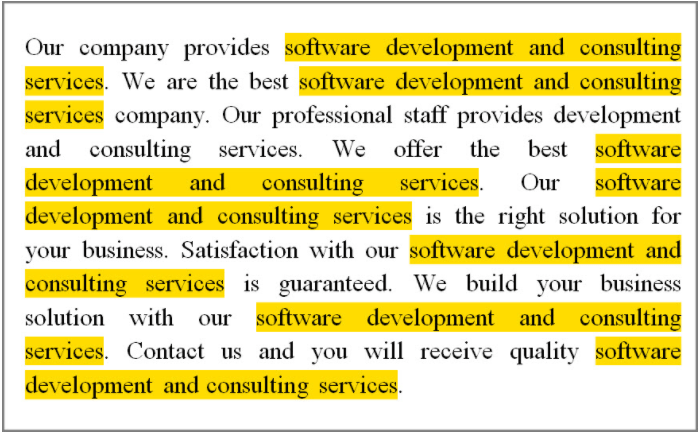Table of Contents
What is Keyword Stuffing?
“Keyword stuffing” refers to the method of loading a webpage with keywords or numbers in an attempt to change a site’s ranking in Google search results. Often these keywords appear in a list or group or outside the context (not as natural prose). Filling pages with keywords or numbers can lead to a negative user experience and damage your site ranking. Focus on creating useful, informative content that uses keywords appropriately and contextually.
Just go through the video below for a more detailed explanation.
Examples of keyword stuffing:
- List of phone numbers that do not have significant added value
- Text blocks listing cities and describing what the webpage is trying to rank
- It is unnatural to repeat the same word or phrase too many times, for example:
- We sell custom cigar humidifiers. Our custom cigar humidifiers are handmade. If you are looking
- to purchase a custom cigar humidifier, please contact our custom cigar humidor experts at
- custom.cigar.humidors@example.com.
Don’t let your SEO keyword stuffing happen
Here’s how to prevent this
When trying to optimize your website for search engines, it can be tempting to take shortcuts. You can try strategies that will speed up the process and help you start a higher rank. But black hat tactics like shortcuts and keyword stuffing won’t help you; They can really annoy you.
Why is keyword stuffing bad for your website?
After reading the keyword stuffing example above, you can see one of the most obvious reasons why this is a bad strategy. It creates an amazing experience for customers.
Website content should aim to educate, serve and engage its readers. When you fill your pages with keywords, you are not fulfilling the purpose. You stop writing for readers and start writing for search engines. This will create a poor experience for your visitors and keep customers away from your page, increase your bounce rates and keep potential customers away from your business. That’s why one should avoid it.
Filling your page with keywords may make you think more people will visit your site, but in reality, it may be the opposite.
Keyword stuffing is widely condemned by search engines and can lead to operational search penalties. Explore the best keyword research tools from here.
In other words, if you fill your page with unnecessary keywords, it will not improve your chances of improving your rank. It reduces them. You may be subject to a Google penalty for removing your page entirely from search engine results pages (SERPs).
So playing the system is exciting, avoid filling pages with keywords. Instead, use the following best practices to properly optimize your pages for keywords.
How to use keywords correctly?
To help rank the webpage for a specific keyword, focus on “optimizing” for the keyword rather than “stuffing” on the keyword. Use the word target in all the right places. And, as the Google Quality Guidelines state, “Focus on creating useful, informative-rich content that uses keywords appropriately and contextually.”
To learn more about researching and using keywords effectively, read: Keyword Research: A Comprehensive Guide.
Follow these 6 steps to promote healthy keyword density:

1. Specify a basic keyword on each page
To enable SEO for a webpage, first select the target keyword. The basic phrase should be relevant to the topic and close to the content. This word must be a popular, low-competitive keyword to improve your ranking chances in search pages for the word.
Once you have used the target keyword on the webpage, do not refer to it as a keyword for other pages on your site. Every page on your site that you want to rank in the search must be assigned its own specific, target keyword. This prevents your content pages from competing with each other and sends a clear message to search engines about what each content is about.
2. Write more than 300 words
To encourage search engines to rank a page for a target keyword, type 300 or more words into the main body copy of the page. Search engines aim to provide the most relevant and useful information available to users and they are likely to rank multiple search terms if your content is thorough and thorough.
3. Use the appropriate basic keyword density in the copy
When you write, use your target keywords throughout the content. Do not overuse it and only place the word where it feels natural and relevant. Keep your keyword density below 2% to be among the best SEO practice guidelines.
4. Add secondary keywords, synonyms, and long-tail keyword variations to the copy
Another way to tell search engines that your page is related to its primary keyword is to use secondary keywords on the page. Search engine crawlers use other words and phrases on the page to get context to help rank the page. So in your copy, use secondary keywords, which are synonyms and long-tailed versions of your primary target word, to strengthen your content and help crawlers rank your page.
Using long-tail variations of your keyword will help search engines locate places in your content to answer questions, allowing you to display your content in Google’s “People Ask” section. Take the opportunity.
5. Place the keywords in the right page elements
When you optimize a page for a keyword, it doesn’t matter where you put the target word in the main body content. It also tells you how to use keywords in other elements of the page. To fully customize the page, use the keyword once in the following places:
- Page title
- At least one subtitle
- Title tag
- Meta description
- At least one image is an alt tag
- The first paragraph
- Near the end of the post
Unlike keyword stuffing, these keyword optimization strategies send positive signals to search engines so that they can observe and rank your page at any time.
6. Check your on-page SEO
Even if you check the checklist for creating a keyword-optimized post, it is easy for search engines to miss or ignore opportunities to make your page more attractive. So after you publish a page, always run a report to check on-page SEO and make sure you do not miss any optimization opportunity.
The Bottom Line
Improve your keyword strategy - Improve your ranking
As you can see, it is not enough to just pick an arbitrary keyword and repeat it over and over again in the hope that you will start ranking in the SERPs. You need research and strategy to optimize your content and rank your pages better than your competitors.
Use the content writing tips in this post to avoid keyword stuffing and improve your SEO strategy in the right way. Learn about digital marketing from here.
Hope You like this information. Don’t forget to share and leave comments. Thank you.





11 Comments
Augusta
Hi there superb website! Does running a blog such as this
require a lot of work? I’ve very little understanding of coding but I had been hoping to start
my own blog soon. Anyways, if you have any recommendations or techniques for new
blog owners please share. I know this is
off topic nevertheless I just needed to ask. Thanks a lot!
inamdurrani60
Ya Augusta it’s true it takes a lot of hard work
You may go through these posts https://mixwithmarketing.com/2021/09/how-to-select-a-profitable-niche-for-your-blog-as-a-beginner/
https://mixwithmarketing.com/2021/09/how-to-create-great-content-for-your-blog-best-tips-for-blog-content/
Lasonya
Keep on working, great job!
inamdurrani60
Thanks lasonya
Roseann
It’s remarkable to pay a quick visit this website and reading the
views of all mates on the topic of this paragraph, while I am also zealous of getting experience.
inamdurrani60
Thanks, Roseann for your engagement
Octavia
Hi there, just became aware of your blog through Google, and found that it is
really informative. I am gonna watch out for brussels.
I will be grateful if you continue this in future.
A lot of people will be benefited from your writing.
Cheers!
inamdurrani60
Thanks Octavia for your appreciation
Christopher
Hey There. I found your blog using msn. This is a very well written article.
I’ll be sure to bookmark it and come back to read more of your useful information. Thanks for the post.
I will certainly return.
inamdurrani60
Thank You Christopher for your gratitude. yes! you are most welcome to our blog please make sure to share content on social media and friends